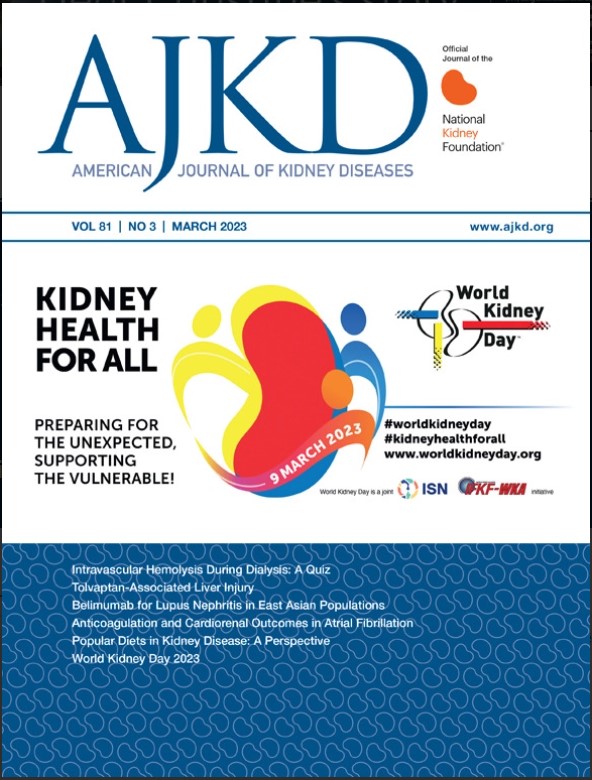血清钠、腹膜透析相关性腹膜炎和死亡率在腹膜透析结果和实践模式研究(PDOPPS)中的关系。
IF 9.4
1区 医学
Q1 UROLOGY & NEPHROLOGY
引用次数: 0
摘要
理由与目的腹膜透析(PD)患者低钠血症的临床后果尚不清楚。本研究旨在评估血清钠的变化与腹膜透析相关性腹膜炎和死亡的关系。研究设计:多中心观察队列研究。设置和参与者:2014年至2022年间,8个国家的23,707名腹膜透析结局和实践模式研究(PDOPPS)的参与者在研究入组时可获得血清钠。预测指标入组时血清钠类别(类别:142 mEq/L)。结果:首次腹膜炎发作时间和全因死亡率。分析方法:根据人口统计学、合并症和治疗特点调整病因特异性危险模型。二次分析采用平均血清钠水平随时间的变化,并评估使用醋酸糊精对血清钠与研究结果之间关系的改变,以及患者特征和腹膜透析(PD)方式。结果与血清钠140 ~ 141 mEq/L (n=5065)组相比,钠<135 mEq/L (n=3601)组透析时间更长,患糖尿病和使用碘糊精的可能性更大。在不同的血清钠类别中,调整后的腹膜炎风险没有差异。与钠含量为140-141 mEq/L的个体相比,钠含量<135 mEq/L(校正危险比[AHR] 1.45, 95% CI 1.29-1.63)、钠含量为135-137 mEq/L (AHR 1.26, 95% CI 1.13-1.42)和钠含量≥142 mEq/L (AHR 1.16, 95% CI 1.03-1.30)的个体死亡率较高。血清钠与死亡率之间的关联在所有患者特征和PD模式亚组中相似。腹膜炎的风险在不同的血清钠类别中没有明显的差异,不管是否用醋酸糊精治疗。不同部位血清钠测量标准化/验证的局限性碘糊精的使用仅限于一小部分患者。结论血清钠变化与死亡相关,但与腹膜炎风险无关。未来的研究需要了解这些关联的机制,以及血清钠的改变是否会改善PD患者的预后。本文章由计算机程序翻译,如有差异,请以英文原文为准。
Associations Between Serum Sodium, Peritoneal Dialysis–Associated Peritonitis, and Mortality in the Peritoneal Dialysis Outcomes and Practice Patterns Study (PDOPPS)
Rationale & Objective
The clinical consequences of hyponatremia among patients receiving peritoneal dialysis (PD) are poorly understood. This study sought to evaluate the association of variations in serum sodium with peritoneal dialysis-associated peritonitis and death.
Study Design
Multicenter observational cohort study.
Settings & Participants
23,707 participants in the Peritoneal Dialysis Outcomes and Practice Patterns Study (PDOPPS) in 8 countries between 2014 and 2022 with a serum sodium measure available at study enrollment.
Predictor
Serum sodium categories (<135, 135-137, 138-139, 140-141, ≥142 mEq/L) at study enrollment.
Outcome
Time to first peritonitis episode and all-cause mortality.
Analytical Approach
Cause-specific hazards models adjusted for demographic, comorbidity, and treatment characteristics. Secondary analyses using average serum sodium levels over time and evaluation of modification of the association between serum sodium and study outcomes by use of icodextrin as well as patient characteristics and PD modality.
Results
Compared to a serum sodium of 140-141 mEq/L (n = 5,065), those with a sodium of <135 mEq/L (n = 3,601) had longer dialysis vintage and were more likely to have diabetes and use icodextrin. Across serum sodium categories, there were no differences in the adjusted peritonitis risks. Compared to individuals with a sodium of 140-141 mEq/L, those with a sodium of <135 mEq/L (adjusted hazard ratio [AHR], 1.45 [95% CI, 1.29-1.63]), a sodium of 135-137 mEq/L (AHR, 1.26 [95% CI, 1.13-1.42]), and a sodium ≥142 mEq/L (AHR, 1.16 [95% CI, 1.03-1.30]) were all associated with higher mortality. Associations between serum sodium and mortality were similar across all patient characteristic and PD modality subgroups. Peritonitis risk was not detectably different across serum sodium categories regardless of treatment with icodextrin.
Limitations
Lack of standardization/validation of serum sodium measures across sites; icodextrin use was limited to a subset of patients.
Conclusions
Variations in serum sodium were associated with death but not peritonitis risk. Future studies are needed to understand the mechanisms underpinning these associations and whether modification of serum sodium would improve outcomes among those receiving PD.
求助全文
通过发布文献求助,成功后即可免费获取论文全文。
去求助
来源期刊

American Journal of Kidney Diseases
医学-泌尿学与肾脏学
CiteScore
20.40
自引率
2.30%
发文量
732
审稿时长
3-8 weeks
期刊介绍:
The American Journal of Kidney Diseases (AJKD), the National Kidney Foundation's official journal, is globally recognized for its leadership in clinical nephrology content. Monthly, AJKD publishes original investigations on kidney diseases, hypertension, dialysis therapies, and kidney transplantation. Rigorous peer-review, statistical scrutiny, and a structured format characterize the publication process. Each issue includes case reports unveiling new diseases and potential therapeutic strategies.
 求助内容:
求助内容: 应助结果提醒方式:
应助结果提醒方式:


